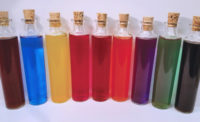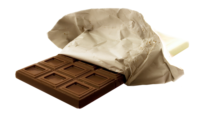We taste with our eyes. Fruit doesn’t come in a grayscale — color is nature’s way of enticing us to choose nutritionally beneficial and tasty produce.
This applies to candy as well. M&M’S, Skittles, lollipops, gum, gummy bears, jelly beans — part of candy’s appeal is the bright and broad spectrum of colors seen in candy.
But pick up a package and read the ingredients list and Red 40, Yellow 5, and Blue 2 will often be what’s behind your rainbow of a snack.
What do these artificial dyes entail? Well, according to a quick Google search, they may cause any number of mild to severe health-endangering claims, anything from hyperactivity in children to cancer. But do these claims hold up in the realm of scientific inquiry, and does it matter to the candy industry?
The answers are maybe, and yes.
“We get the sense that social and cultural factors are main drivers behind this movement, rather than science, since in reality artificial colors undergo more thorough scrutiny, testing, and certification than their natural counterparts,” says Jerry Owens, marketing director, S&S Flavors.
While there are natural solutions to all those infamous artificial dyes, it might be a lot of fuss over nothing.
For instance, with California’s 4-MEI proposition came the warning that caramel color, commonly used in anything from soda to instant oatmeal to candy, is a potential carcinogen. In reality, caramel color is just burnt sugar.
David Dukes, president and owner, IFC Solutions, explains that some customers are concerned about using caramel color, and are seeking to replace it with natural color blends to achieve the same shade.
Caramel color is cheap, but natural colors to match the caramel color share can be 10-20 times more expensive. Companies are producing it though, and at IFC Solutions “we have some wonderful natural brown colors” to offer, says Dukes.
The question of whether synthetic colors are harmful can depend dramatically on individuals, so widespread shunning of the products may be a bit over-the-top.
One study put out by the University of Southampton has demonstrated a link between synthetic colors and ADHD (attention-deficit/ hyperactivity disorder). In addition, some people experience allergic reactions to synthetic materials, according to Leslie Lynch, sales manager, Food Ingredient Solutions, LLC.
So, in lieu of artificial colors, naturally derived colors are fast gaining popularity.
“We see more and more requests for natural colors every day,” says Scott Ondracek, associate food science chemist, DDW Color. “Customers are becoming more savvy about what ingredients are used in their foods and food companies are looking to meet those demands. Ten years ago, 5 percent of the color requests DDW received outside of caramel color were for naturally derived colors — today, that number has risen to around 50 percent.”
As consumers demand natural colors, companies are responding — though this doesn’t guarantee a smooth and flawless transition.
“Natural colors are inherently more challenging to work with than artificial colors,” says Owens. “They are not as consistent or vibrant as customers are used to with artificial colors, they are more susceptible to heat, light, oxidation, and acidity issues, and they are more costly.”
Dukes echoes this. “They’re really expensive. Hundreds of dollars a pound. Artificial blue is twenty dollars a pound.”
“The immediate future depends on how consumers react to higher costs and sometimes lower performance with respect to stability, visual appeal, and taste of the end product,” explains Owens.
He also believes that as time goes on, technology will improve, costs will come down, and performance will improve. There may, however, always be a need for some artificial colors in some instances because of the limits of natural food coloring.
For natural colors, sourcing can be one of the most challenging components.
DDW Color has production facilities on five continents, yet it takes a global outreach to collect all the colors they need to provide for their customers. From annatto seeds in Peru or Ivory Coast to turmeric oleoresin from India, it requires a great deal of effort to produce results.
Since natural colors almost always come from harvested crops, seasonal variations can affect crop growth and therefore the raw products. Natural colors can vary from crop to crop, so the right balance is key to achieving consistent results. Even then, this isn’t always possible.
So, are all these lengthy efforts worth it?
If consumers are willing to pay more, as it seems to be the case with the frequently raised suspicions concerning artificial colors and the millennial generation making it clear they will spend more for healthier food, then it seems the only way from here is up.
Dukes explains that since IFC Solutions offers natural, certified organic, artificial and pearlescent food colors, it really does not matter which option a customer requires. They will custom blend any of these colorants to produce liquids, pastes or powders to the customer's specifications.
While finding natural solutions to artificial colors can be an intensive and expensive process, it’s something consumers and media continue to push for. Natural, organic, non-GMO — these are all sought-after labels, and companies are willing to buy more expensive ingredients so they can get this label, according to Owens.
And there are truly, scientifically-backed reasons to go for natural dyes. Colors derived from red cabbage or radishes are anthocyanin-based and have been shown to have antioxidant properties. Beta-carotene, which can make red, orange, and yellow, is also beneficial, as it’s a vitamin A precursor.
“Synthetics will never be eliminated completely, but natural colors will become more prevalent in foods and the growth of the natural color industry will increase at a more rapid rate than synthetic colors,” says Lynch. To the point that “many food producers... only consider natural colors in new product development.”
Food producers in the European Union have all but done away with using synthetic colors, a trend that’s taking roots in the United States.
It looks like candy is taking some advice from nature — using bright colors to attract — but this time, it’s the natural way.
S&S Flavors is a custom manufacturer of original flavors for industries ranging from confectionery to pharmaceutical. They use only the finest raw materials to achieve the best possible finished products. Certifications include QAI Certified Organic Compliant and Orthodox Union Kosher.
IFC Solutions specializes in dispersing color into FDA approved ingredients to develop unique, high quality color concentrates. They produce colors in a variety of formats to make the job of coloring food, confectionery, and cosmetic products easy and economical.
Food Ingredient Solutions LLC manufactures a complete range of natural colors and natural color preparations for the food, drug and cosmetics industries.
DDW The Color House strives to enhance the visual appeal of foods and beverages through naturally derived colours. With nine natural coloring operations on five continents, they provide colorings for confectionery to beverages to baked goods to beer, and everything in between.
And with companies like that leading the way, the future of natural colors looks bright.










